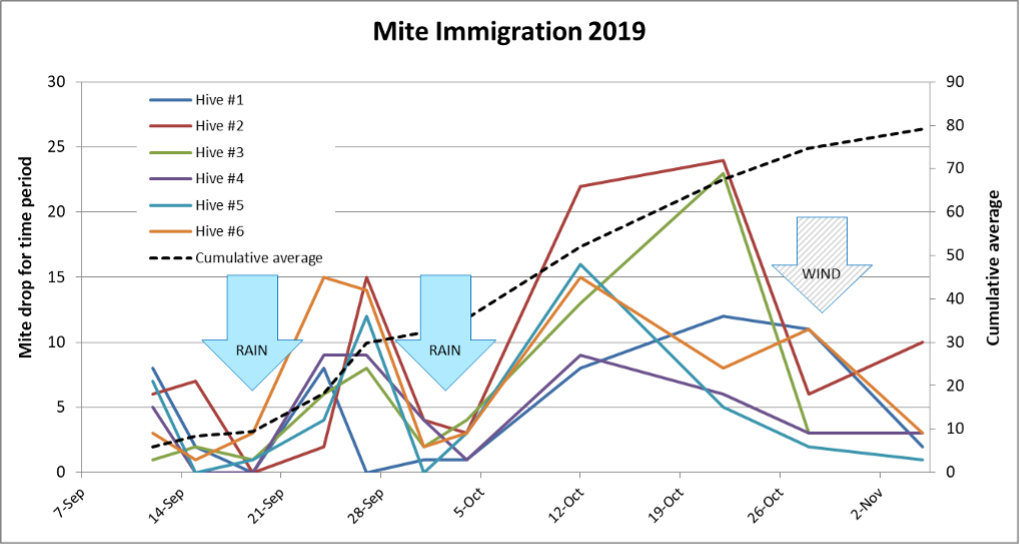A Study on Bee Drift and Mite Immigration: Part 4
Contents
Distance that Worker Bees will Drift 1
Effect of Distance upon Bee Drift 4
Hive-to-Hive Variation in Captured Tags 7
Mite Immigration: Results of the Stickyboard Counts. 10
Cumulative Mite Immigration. 11
A Study on Bee and Mite Drift:
Part 4
Randy Oliver
ScientificBeekeeping.com
First published in ABJ May 2023
The results that I presented last month suggested that perhaps 5-10% of our tagged bees drifted to other colonies in the neighborhood, and (surprisingly) that drifting didn’t appear to be necessarily correlated with either the degree of mite infestation of the bees, nor the timing of collapse. So let’s move on to what else we learned.
I left off last month with a number of yet-unanswered questions. So let’s start off with one of great interest to beekeepers:
Distance that Worker Bees will Drift
Question: How far from collapsing colonies will bees (and hitchhiking mites) drift?
In order to answer this question, we had placed magnetic entrance traps on 24 Receiver hives at distances from 15 feet to three miles from the Donor hives (Figure 1).
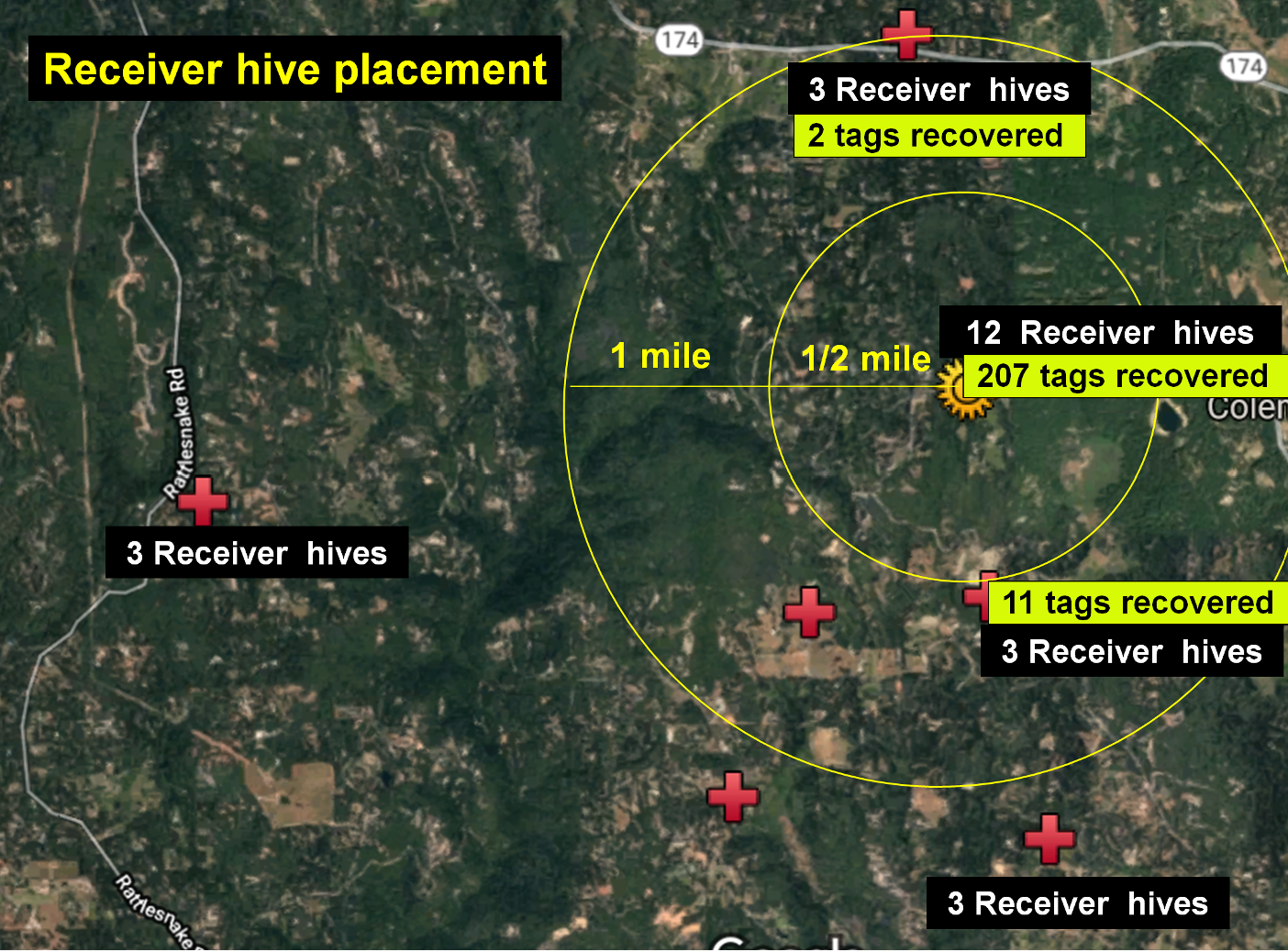
Fig 1 The approximate layout of the Receiver hives. The Donor hives were at the center of the golden star. Drifted tag recovery is indicated in the green boxes. We recovered the vast majority of the tags from our Home yard, but also 13 tags (6% of the total) from two of the outyards.
Although we started tagging bees on the 17th of September, we didn’t recover our first tag in an outyard (a half mile distant) until nine days later (Figure 2).
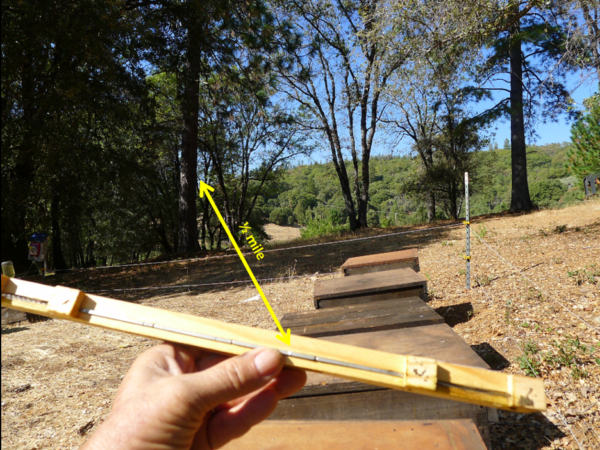
Fig. 2 Bingo ― our first tag in a distant outyard! It wasn’t until nine days after we initiated tagging that we recovered the first tag from an outyard (the white dot at the tip of my thumb) — proof that bees can indeed drift over a wide neighborhood. The arrow indicates the direction to the Donor colony back home ― a half mile distant (and over two valleys). Despite placing magnetic traps on only three of the 30 hives in this outyard, we still recovered, over the course of the study, 11 tags from drifted bees (from seven different Donor colonies), indicating that substantial worker drift at this distance was “normal.”
How substantial? Since we only tagged roughly one bee out of 30 workers in each Donor hive, and placed magnetic traps on only three hives out of thirty at this yard, we can extrapolate that those 11 recovered tags suggest that a total of roughly 3000 bees drifted from the 11 Donor colonies to this yard a half mile distant!
Keep in mind that this experiment was run in an area with diverse landscapes, vegetation, and elevations (Figure 3), so we don’t know how this finding would apply to flatlands.
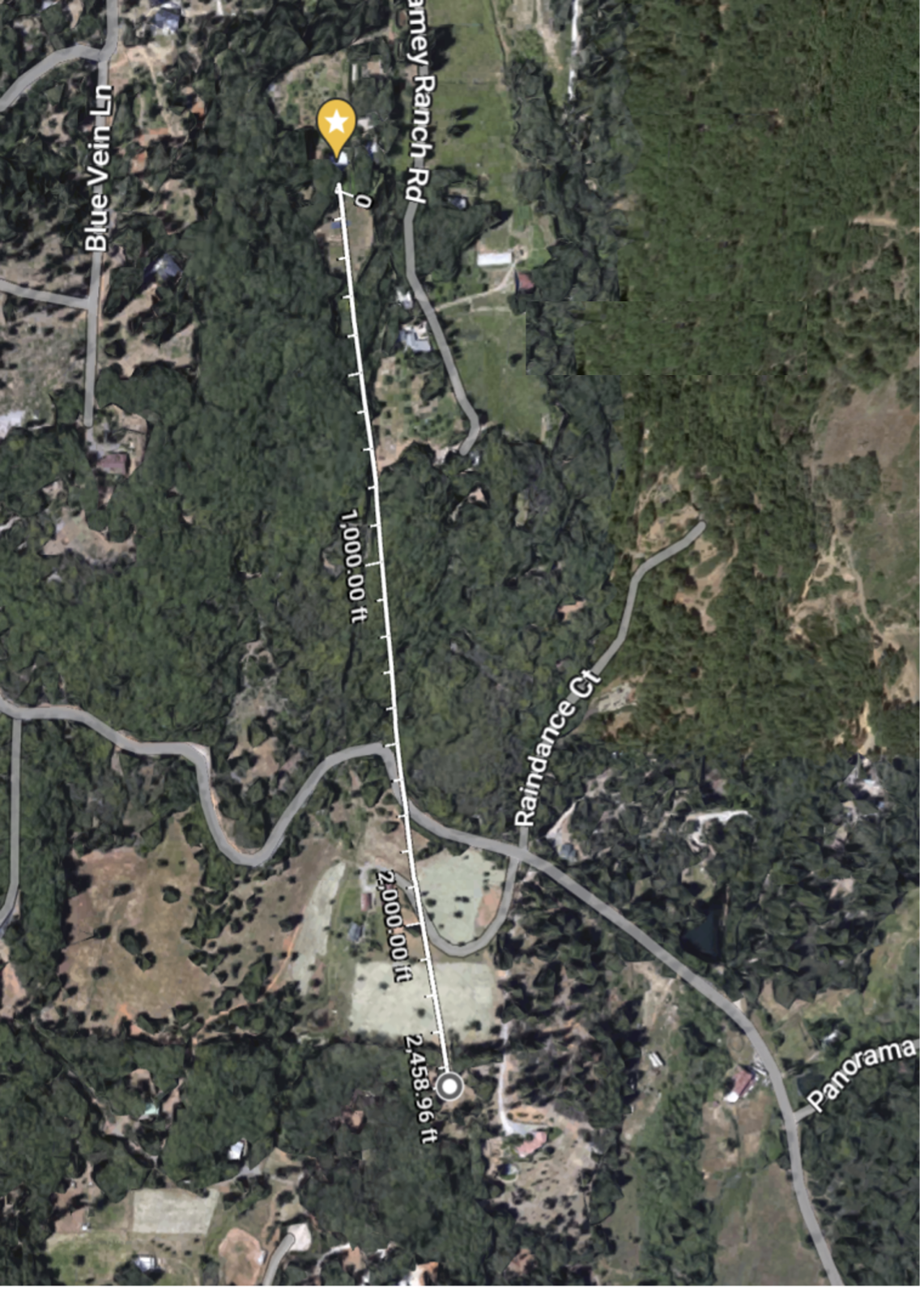
Fig. 3 This map shows the landscape between the Donor colonies at my place at the top, and our apiary to the south where we recovered the tags from 11 drifted bees. The road is at the bottom of a valley. We were amazed by the amount of drift to this location, not only due to the distance, but also because it involved flight over forest, two valleys, across a hayfield, and into an apiary hidden by oak forest. Why the heck would so many bees drift to strange colonies so far away?
We also recovered another two tags from three hives (out of thirty), those hives were well-hidden by trees and a fence, at a distance a full mile in the opposite direction, indicating that there was appreciable bee drift occurring even at that distance. This leads us to another question:
Effect of Distance upon Bee Drift
Question: How does the drift of bees to nearby hives compare to that to those more distant?
Figure 4 shows average tag recovery per Receiver hive by distance from the Donors.
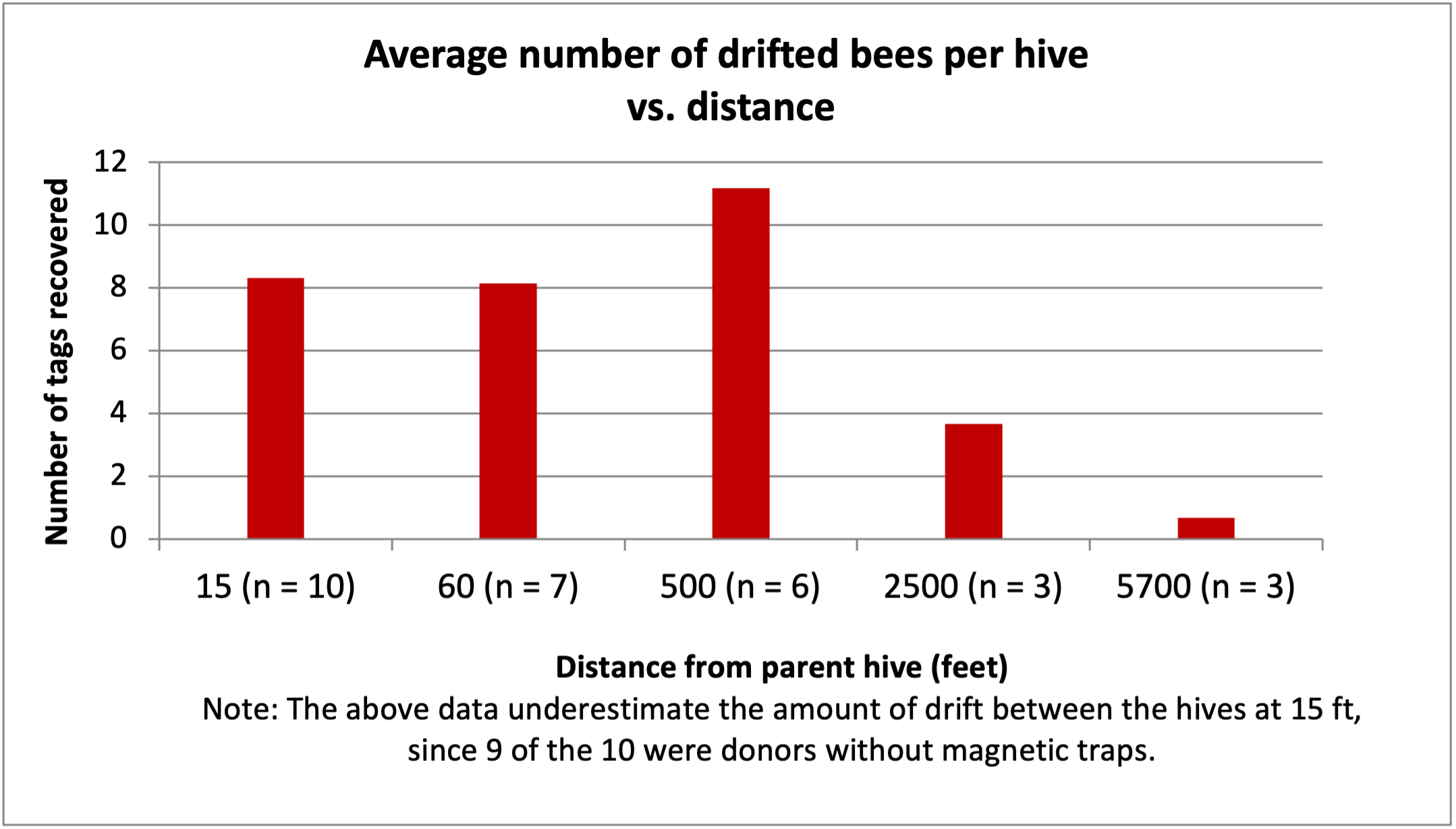
Fig. 4 What really surprised us was how great the drift was to the hives 500 feet distant, compared to those in plain sight of the Donors at 60 feet. Not only were those Receivers located uphill, there were several buildings, trees, and other obstacles and landmarks between them and the Donors.
The above distribution of drifting bees was completely unexpected, and certainly wouldn’t be expected by chance. Take a look back at Figure 1 — for each distance from the Donors, the surface area of the landscape increases by the square of the radius [[1]]. Thus the likelihood of a drifted bee randomly landing near another hive decreases exponentially with distance.
So I ran some calculations, based upon two assumptions: (1) since there was minimal nectar flow taking place during this time period, there would be no reason to expect that a drifted bee would be more likely to fly near any particular Receiver hive location than another, and (2) the presumably false assumption (since we know that workers tend to forage as close to their hive as possible) that a drifted bee would be as likely to land a mile from its hive as it would to land more closely (which would underestimate the calculated disparity between the expected and observed values (Table 1 and Figure 5).

Fig. 5 The blue plot indicates the likelihood by chance of a drifted bee landing within 10 feet of a Receiver hive relative to the surface area of the landscape encompassed by that distance (the probability quickly approaches zero). The red plot is our actual percent tag recovery. The boldface numbers indicate the proportional increase over what would be expected by chance. As explained above, the fold-increase numbers are likely underestimations.
Our data clearly indicate that the drifted bees didn’t just randomly wind up in distant hives by chance — something clearly drew them to those hives.
Interpretation: The above was the most unexpected (and interesting) finding (to me): that our tagged bees drifted into more distant hives at a rate disproportionally far greater than expected by chance. Both scientific literature and field observations indicate that honey bees exhibit remarkably accurate navigation and homing ability. I can understand how a returning bee might drift to an adjacent hive, but why would the rate of drift to distant hives be so disproportionately high?
Perhaps foragers are more likely to get lost, disoriented, or confused as they get further from their homes. Could it have been because during my study — due to little nectar or pollen flow taking place — that the foragers were exploring further from their hives than they would have been had nearby forage been more abundant? One explanatory hypothesis would be that that when a bee gets disoriented, that it simply flies upwind toward the scent of the nearest hive. Or are some foragers simply unable to resist the alluring scent of another colony? This is a question crying for more research — which would be easy to do with these magnetic tags and traps.
The above discussion brings up another one of our questions:
Hive-to-hive Variation in Captured Tags
Question: Are some colonies more (or less) attractive to drifting bees (and thus mites) than others?
This subject was raised in this very journal clear back in 1932 by George King [[2]], who described the results of his study (at the University of Illinois) on the drifting of marked bees:
It was found that the amount of drifting between colonies was often over 30 percent of the total number of bees. [His test colonies were in a row, spaced 4-8 feet apart].
He noted that:
There are factors other than the distance of colonies from each other which influence drifting.
King wrote that:
Frequently one colony appears to outyield other colonies near it, and so the queen in it is selected as a suitable mother to requeen the apiary. She should be a choice queen if she is responsible for the extra showing made by her colony. However, if workers reared in neighboring colonies have drifted into her colony without an equal drift back into them, the queen cannot be credited with the results shown.
Dr. Jerry Bromenshenk (pers comm), using entrance counters, also found that some colonies gained strength due to consistently having more bees entering than exiting — indicating that drifters were continually adding to the populations of some hives in an apiary (the reverse was also true). Jay [[3]] and Pfeiffer [[4]] found that with hives placed in a row, those at the ends may pick up additional drift, but Bromenshenk found that it could also be independent of relative placement.
King’s concluding remarks were prophetic:
There are so many things to consider in beekeeping of which so little is known that more information is certainly desirable. One of the things which will bear considerable investigation is drifting.
Ninety-one years later, I couldn’t have said it better myself! Now back to our findings …
In Figure 6 we can see that some of the home yard Receivers appeared to be more (or less) attractive to drifting bees (I’m not clear whether guarding behavior made a difference, since a drifted bee only needed to make it to the entrance to be snagged by the magnetic trap).
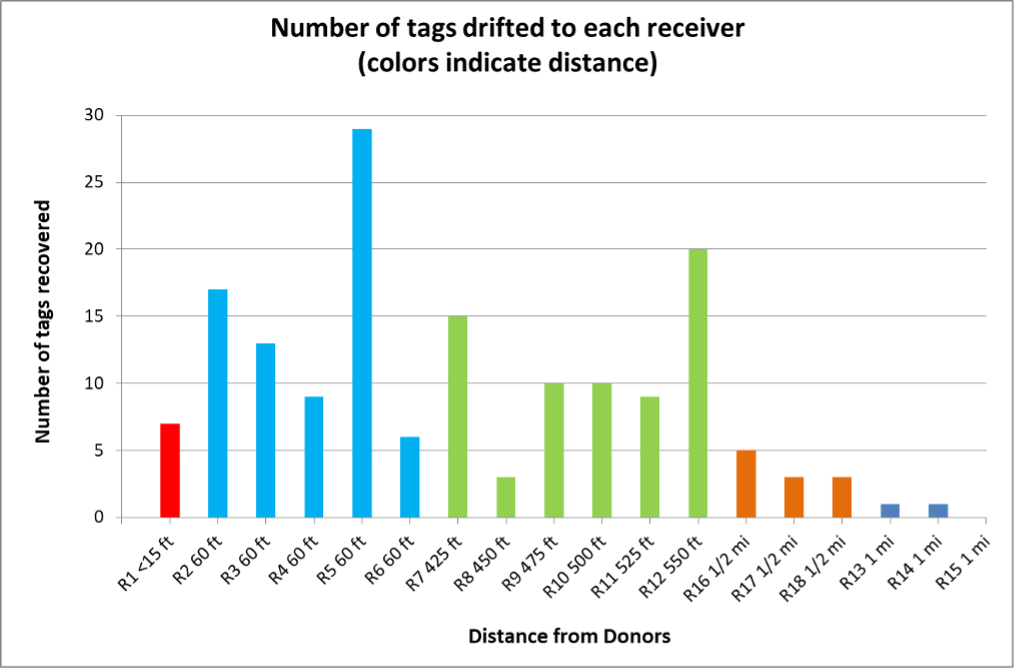
Fig. 6 I’ve color-coded the hives by their distances from the Donor hives (the nonmagnetic capture from the Donor hives is not shown). Note that in any distance group, some colonies appeared to be more (or less) attractive to drifting bees than others (despite all hives being identically sized and colored, mostly of the same bee stock, and of roughly equal strength).
So how about my haphazard choices for the three hives to which I applied traps out of the thirty in each outyard? I have no idea as to whether they were individually attractive or unattractive to drifting bees ― so they may have over- or underestimated average drift to those yards.
The question then arises as to whether colonies that attract or allow more ingress of drifting bees also suffer more greatly from mite immigration. So let’s move on to what we found about the association between worker drift and mite immigration:
Validating our Methodology
In order to quantify mite immigration, we had to maintain Receiver colonies that were virtually free of mites (and mite reproduction). We did this by use of continual miticide treatment. We started taking formal stickyboard counts on 17 September — later than I’d hoped for, since we were already seeing substantial mite drop in our preliminary checks. This made me wonder whether our Receiver colonies were really mite free. So we performed alcohol washes on two dates to confirm (Table 2).
Despite all colonies still exhibiting very low infestation rates of the adult bees (which could have been from recently-immigrated mites), I was still curious whether R5 and R7, which exhibited consistently high sticky counts, were generating their own mites. So on 17 October I dissected 100 cells of white-eyed pupae to pre-emerging adults from R5 (Figure 7). There were zero mites. R7 was completely lacking sealed brood — no larvae were past third instar, indicating that the Carniolan colony had shut down brood rearing some time ago, only to restart a few days before inspection (so no mites could have been in the brood). These findings strongly supported that their stickyboard counts were apparently due solely or at least mainly to incoming mites.
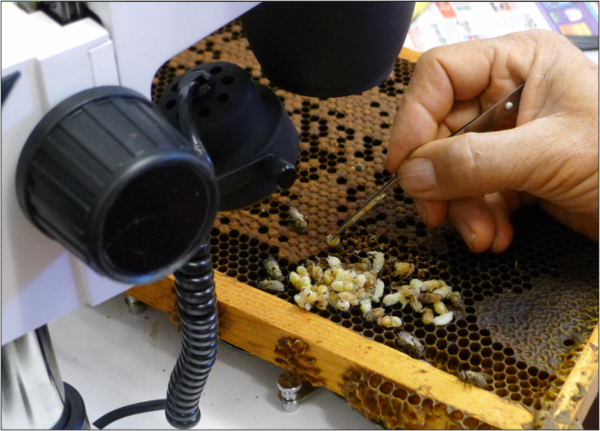
Fig. 7 I didn’t find evidence of a single mite in the hundred pupal cells that I dissected, confirming that little or no mite reproduction was taking place in the colony with the highest daily mite drop.
Field research note: It’s important for a researcher to continually question not only their interpretation of their data, but also the validity of their methodology.
Still, I questioned whether, despite my repeated zero mite wash counts, brood dissections, and the final November rainy days check, whether our stickyboard counts truly reflected mite immigration, as opposed to surreptitious mite reproduction within the colony. So in 2019 I replicated treating receiver colonies and taking stickyboard counts from six colonies in the same yard over roughly the same time period. This time the weather was even more helpful! Take a look at Figure 8.
Fig. 8 This time there were three flight-suppressing weather events, which again confirmed that the mite drops in treated Receiver hives was due to drifting bees.
O.K., now that I’m comfortable with our methodology and data, let’s see what we found.
Mite Immigration: Results of the Stickyboard Counts
The collapsing Donor colonies were rife with mites on the workers (Figure 9).
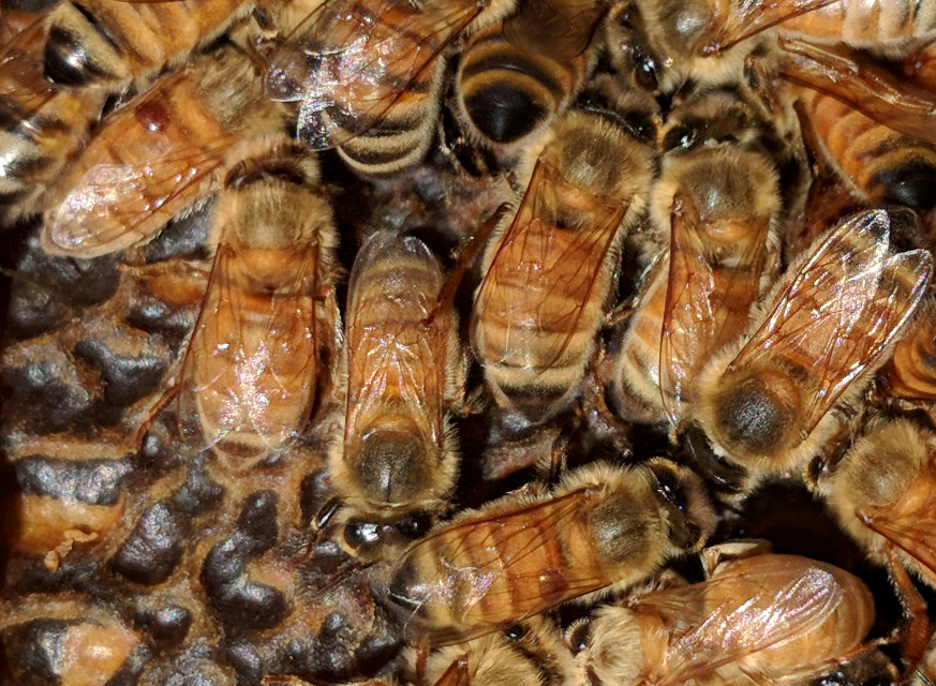
Fig. 9 By 15 October several Donor colonies were clearly collapsing — most with plenty of marked bees still on the combs. Note the high varroa infestation rate in this photo from a collapsing colony — here you can see two workers with a mite on their back (keep in mind that most mites ride on the belly).
So let’s answer some more of our questions, starting with two that we can answer at the same time:
Cumulative Mite Immigration
Question 1: How many mites actually immigrated into our Receiver hives in late summer and fall?
Question 2: Do all colonies suffer equally from mite immigration?
We recorded semi-weekly stickyboard counts from the Receiver hives, and counted a total of nearly 3000 mites, the vast majority of which were likely immigrants. So let’s take a look at the cumulative counts (Figure 10).
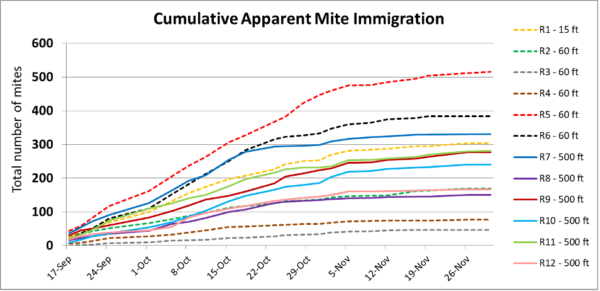
Fig. 10 Receivers R5 and R6 (at roughly 60 feet from the Donors) had the highest immigration totals, whereas the adjacent R3 and R4 had the lowest ― go figure! And it’s clear that the amount of mite immigration differed greatly from hive to hive, regardless of placement. Overall, the Receiver colonies received an average of 245 apparently-immigrated mites over this time period (R5 got over 500).
Practical application: On the same property, with nine collapsing colonies, there was huge hive-to-hive variation in the number of mites that hitchhiked into Receivers up to 550 feet distant. Surprisingly, the amount of immigration wasn’t related to their proximity to the collapsing hives.
The 160 tagged bees that we know drifted to the 12 Home Receiver hives may not seem like a large number, but keep in mind that we only tagged an estimated 1/30th of the total number of workers in each donor hive (which started at average cluster sizes of greater than nine frames covered with bees), and then recovered tags from only 2.7% of those. So we can extrapolate that on average, each Home Receiver had an average of 360 Donor bees drift into it, the vast majority of which would have been untagged.
Practical application: Even with nine colonies collapsing from varroa in the Home yard, the above calculated amount of heavily-infested drifting bees could only account for an average of about 70 out of the average 245 mites that showed up on the stickyboards. This is a nagging question to me — did most of those mites come from elsewhere, or did our recovery of tagged bees not fully represent the actual degree of bee (and mite) drift from the Donors that actually took place? We may be able to answer this with a deeper analysis of our data.
Next Month
In the next installment, we’ll take a deeper look into our data, and address our remaining questions:
Question: Is mite immigration steady or episodic?
Question: How closely did mite immigration correlate with the drifting of tagged bees?
Question: Did mite immigration correlate with robbing at my location?
Acknowledgements
Thanks again to my helpers Brion and Alice Dunbar, Sandy Honigsberg, Anna Mudd, and Brooke Molina.
Citations and Notes
[1] Surface area = ![]()
[2] King, GE (1932) Drifting bees may make production records of little value. Am. Bee J. 72: 141-142.
[3] Jay, SC (1969). Drifting honeybees in commercial apiaries v. Effect of drifting on honey production. Journal of Apicultural Research 8(1): 13-17.
[4] Pfeiffer, K & K Crailsheim (1998) Drifting of honeybees. Insectes Sociaux 45: 151-167.




